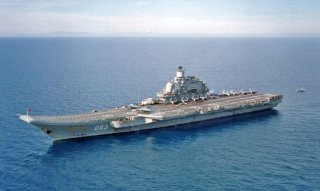No More Aircraft Carrier for Russia? It Might Not Be a Bad Idea.
We lay it all out.
Now Moscow might no longer have that option. But that doesn’t mean Russia can’t deploy naval power. The Russian fleet’s newer corvettes, which are a fraction of the size of a Cold War cruiser, lack range and must remain close to home.
The Russian navy might decommission its only aircraft without directly replacing the vessel, leaving Moscow’s fleet without any prospect of at-sea air cover for the first time in decades.
(This first appeared several weeks ago.)
Admiral Kuznetsov, the Russian navy’s sole flattop, in October 2018 suffered serious damage at the 82nd Repair Shipyard in Roslyakovo, a northern port city, when the PD-50 dry-dock sank while Kuznetsov was aboard for repairs.
Dry-docks lift ships out of the water, allowing workers to access their lower hulls for deep maintenance.
Swedish-built PD-50 was the only large dry-dock capable of supporting the Russian northern fleet’s largest warships. Russia's other large dry-docks are thousands of miles from the fleet's main northern bases.
Moving the docks, or the ships needing repair, could be prohibitively difficult, expensive and time-consuming. Beside the cost, foreign sanctions complicate the acquisition of a dock similar to PD-50.
Now, according to the newspaper Izvestia, the Kremlin might just decommission Kuznetsov rather than spend the money to acquire a new dry-dock, move an existing dock or the carrier or find some other way of repairing the aging, unreliable and accident-prone flattop.
“Not everyone considers the continuation of repair to be appropriate,” a navy source reportedly told Izvestia. “There are different opinions, including those that boil down to the fact that with this money it is better to build a pair of frigates or a nuclear submarine.”
Even if Kuznetsov can be repaired, the navy most likely strictly will use the carrier as a training ship, a Kremlin source told Belsat, a Belarusian news agency.
PD-50 accidentally sank on Oct. 29, 2018 after an electrical malfunction resulting in pumps overfilling the dock's ballast tanks. Four shipyard workers were hurt.
The 60,000-ton Kuznetsov remained afloat during the sinking but suffered damage from a collapsing crane. "It's not clear what will happen to Kuznetsov now," Pavel Podvig, an independent expert on the Russian military, said at the time.
Even before PD-50's sinking, the Russian fleet was slowly replacing big, old ships with much smaller new ones that can't sail as far or carry as much weaponry, but which are cheaper and easier to operate and repair than the old vessels are.
The Kremlin bought four new, small warships in 2018. The Russian fleet numbers some 300 vessels, most of them displacing just a few thousand tons. For comparison, the U.S. Navy has roughly the same number of ships, but they are, on average, much larger.
Kuznetsov commissioned in 1990. Problems plagued the ship from the beginning. One of Kuznetsov’s major weaknesses is her powerplant. The vessel is powered by steam turbines and turbo-pressurized boilers that Defense Industry Daily generously described as “defective.”
Anticipating breakdowns, large ocean-going tugs have accompanied Kuznetsov whenever she has deployed.
Her pipes are bad. “When it’s this cold, water freezes everywhere including pipes which may cause a rupture,” English Russia reported. “To prevent this, they just don’t supply almost 60 percent of the cabins with water (neither in winter nor in summer). The situation with latrines is just as bad. The ship has over 50 latrines [for 1,900 crew] but half of them are closed.”
“In the immediate post–Cold War years, [Kuznetsov] rarely went to sea—conducting only six patrols between 1991 and 2015,” Defence Blog explained. “In 2009, an electrical accident killed a crewman off the coast of Turkey. But Russia has repeatedly pushed the ship into service, and a 2016 mission off the coast of Syria saw the ship lose two jets in just three weeks.”
Before October 2018, Moscow planned on extending the service lives of its carrier and other warships from the 1980s in order to complement the newer vessels. For long-range deployments across the Atlantic or to war zones such as Syria, Russia tended to send Kuznetsov and equally aged, Soviet-built destroyer and cruisers.
Now Moscow might no longer have that option. But that doesn’t mean Russia can’t deploy naval power. The Russian fleet’s newer corvettes, which are a fraction of the size of a Cold War cruiser, lack range and must remain close to home.
But long-range missiles and land-based air cover can obviate the need for a ship to travel across the sea with an aircraft carrier for protection. In recent years, corvettes from the Caspian Sea fleet have fired long-range Kalibr cruise missiles at targets in Syria -- all without ever leaving Russian waters or the cover provided by land-based fighter planes.
A shortage of accessible dry docks for repairing bigger ships weighs on the Kremlin's naval planning. In that way, PD-50's sinking and Kuznetsov’s potential decommissioning could accelerate the Russian fleet's transformation into a force that’s easier to maintain.
When the big ships decommission, smaller ones armed with long-range missiles could take their place. As a bonus, small ships don’t need huge, sinkable dry-docks for repairs.
David Axe serves as Defense Editor of the National Interest. He is the author of the graphic novels War Fix, War Is Boring and Machete Squad.
Image: Wikimedia

